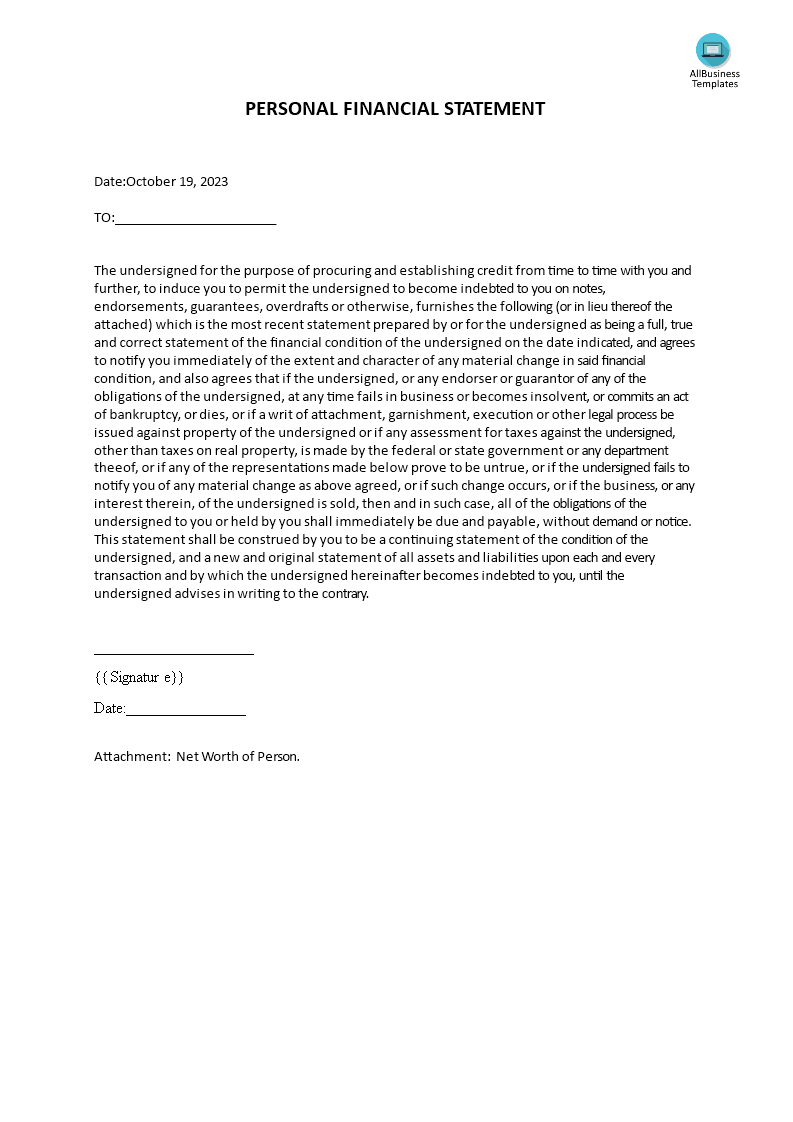Personal financial Statement
Save, fill-In The Blanks, Print, Done!

Download Personal financial Statement
Today: USD 1.49
Download It Now

Available premium file formats:
Microsoft Word (.docx)Other languages available:
- This Document Has Been Certified by a Professional
- 100% customizable
- This is a digital download (24.7 kB)
- Language: English
- You will receive a link to download the file as soon as your payment goes through.
- We recommend downloading this file onto your computer.
What is a personal financial statement template? How do I make my own personal financial statements?
We have a variety of templates available for you to use. Our templates are comprehensive and easy to use. We also provide you with helpful guidance on how to complete and submit your financial statements.A Personal Financial Statement (PFS) is a document that provides a comprehensive overview of an individual's financial position at a specific point in time. It typically includes information about a person's assets, liabilities, and net worth. Personal financial statements are commonly used for various purposes, such as assessing one's financial health, applying for loans, mortgages, or credit, estate planning, or simply gaining a better understanding of one's financial situation.
Creating your own Personal Financial Statements involves gathering and organizing your financial information to provide a clear snapshot of your financial situation. Here are the steps to make your own Personal Financial Statements:
- Gather Financial Documents:
- Collect all relevant financial documents, such as bank statements, investment statements, loan statements, credit card statements, and any other records that reflect your financial transactions and account balances.
- List Your Assets:
- Create a section for your assets, which includes everything you own that has financial value. Common assets include:
- Cash and cash equivalents (savings accounts, checking accounts)
- Investments (stocks, bonds, mutual funds)
- Real estate (homes, rental properties)
- Vehicles
- Retirement accounts (401(k), IRA)
- Personal property (jewelry, collectibles)
- Determine the Value of Your Assets:
- For each asset, note its current market value or the value you would receive if you were to sell it today. This may require estimating the value of personal items or obtaining appraisals for valuable assets like real estate.
- List Your Liabilities:
- Create a section for your liabilities, which includes all your financial obligations and debts. Common liabilities include:
- Mortgage loans
- Auto loans
- Credit card debt
- Student loans
- Personal loans
- Other outstanding loans or lines of credit
- Determine the Amount of Your Liabilities:
- Note the outstanding balances for each liability. This information can be found on your loan or credit card statements.
- Calculate Your Net Worth:
- Subtract your total liabilities from your total assets to calculate your net worth. This will give you a clear picture of your financial standing.
- Include Income and Expenses (Optional):
- While not required for a basic Personal Financial Statement, you can include a section that details your sources of income and monthly or annual expenses. This can help you analyze your cash flow and budget.
- Update Regularly:
- Your financial situation can change over time. Make it a habit to update your Personal Financial Statements regularly, such as quarterly or annually, to reflect any changes in your assets, liabilities, income, or expenses.
- Use Financial Software or Templates:
- Consider using financial software or templates available online to streamline the process of creating and updating your Personal Financial Statements. There are many spreadsheet templates designed for this purpose.
- Seek Professional Advice (Optional):
- If you have complex financial situations, significant investments, or tax-related matters, you may want to consult a financial advisor or accountant to assist you in creating and analyzing your Personal Financial Statements.
Remember that a Personal Financial Statement is a valuable tool for understanding your financial health and planning for your financial future. It can also be useful when applying for loans or mortgages or for estate planning purposes.
Using our business templates guarantees
you will save time, cost, and effort and helps you to reach the next level of
success in your education, work, and business!
Download this professional
Personal Financial Statement template now!
For more business templates? Just browse
through our database and website! You will have instant access to thousands of
free and premium business templates, legal agreements, documents, forms,
letters, reports, plans, resumes, etc., which are all used by professionals in
your industry. All business templates are ready-made, easy to find, wisely
structured, and intuitive.
DISCLAIMER
Nothing on this site shall be considered legal advice and no attorney-client relationship is established.
Leave a Reply. If you have any questions or remarks, feel free to post them below.
Related templates
Latest templates
Latest topics
- GDPR Compliance Templates
What do you need to become GDPR compliant? Are you looking for useful GDPR document templates to make you compliant? All these compliance documents will be available to download instantly... - Google Docs Templates
How to create documents in Google Docs? We provide Google Docs compatible template and these are the reasons why it's useful to work with Google Docs... - IT Security Standards Kit
What are IT Security Standards? Check out our collection of this newly updated IT Security Kit Standard templates, including policies, controls, processes, checklists, procedures and other documents. - Letter Format
How to format a letter? Here is a brief overview of common letter formats and templates in USA and UK and get inspirited immediately! - Google Sheets Templates
How to work with Google Sheets templates? Where to download useful Google Sheets templates? Check out our samples here.
cheese
